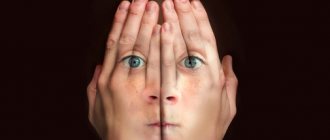Read more about conversion disorder
The definition of “conversion” refers to the exclusively psychological root cause of the phenomenon, which expresses itself not at the psychological level (for example, anxiety), but through physical symptoms reminiscent of signs of a nervous system disorder.
They usually appear from mental stimuli like conflicts. In most cases, the ability to swallow, walk, hear or see is impaired. According to most scientists, improvements can be observed in patients with the help of a timely and correct approach to treatment.
Photo by Jesper Aggergaard on Unsplash
There is a chance of paralysis of an arm or leg, or patients may lose their sense of touch. Doctors usually conduct quite a lot of medical examinations and tests to make sure that such manifestations are not a consequence of a physical illness.
Encouragement from a trusted loved one or the use of hypnosis may help. Conversion disorder, in most cases, appears between infancy and early adulthood, but the disorder can appear at any time.
How to recognize dissociative disorder
Patients with DR share the following characteristics:
- amnesia for the events of school years;
- memory lapses, disorientation in time;
- confusion with dates;
- statement about oneself in the third person;
- feeling of extraneous noise in the head, presence of voices;
- the inability to explain the appearance of certain things in the house;
- people greet the patient, call him by name, but he does not know them;
- relatives tell episodes with their participation, which patients do not remember;
- sudden, uncontrollable appearance of incomprehensible thoughts that do not belong to the patient.
In addition to the main signs, there are general symptoms such as:
- headaches, sleep disorders;
- mood instability;
- eating disorders;
- panic attacks;
- anxiety and phobias;
- depression, suicide attempts;
- sexual dysfunction;
- self-harm.
There are many examples of patients with DID, each of which is unique. Here is the story of a girl in whom 12 other selves coexisted at once. One of them was a little girl of three years old who loved strawberry gum and a cartoon about a little pony. She could wake up her parents in the middle of the night to ask for a walk or show her drawing. I spent days watching TV and painting the walls.
In contrast to the little girl, there was a malicious woman who forced the girl to hurt herself. This happened as a punishment for the wrong actions of the main personality. On the other hand, this subpersonality came to the defense if there was a threat. Once a young man tried to raise his hand against a girl, then a malicious woman intervened, pressing the guy to the wall.
Another alter state is also a young girl. She is charismatic, sociable, and loves to be the center of attention. Such traits contradict the character of the hostess. At first, the girls didn’t get along, and the shocking subpersonality tried to do something contrary to the main one: dye their hair inappropriately, dress inappropriately. Then the “main” girl decided to make friends with her. And since then they have coexisted in harmony. The rebel, replacing her, could go to school and do the usual household chores. In general, she behaved with dignity.
There are also some incidental cases. The accused and the victim, both with DID, met in court. The accused is a mature man, he is charged with illegally entering the home of the injured woman and committing an act of sexual violence against her. The man denies his guilt, claiming that the actions were committed by one of his 30 subpersonalities – Spirit with one of the other “I”s of the victim – Laura.
Causes of conversion disorder
A significant cause of the disorder may be a nervous shock or a situation leading to the emergence of generative symptoms as a symbolic expression of past mental strife, or rather a problem when the patient shows high demands on other people, ceasing to intelligently weigh the circumstances around him.
The body creates a protective reaction under the guise of an imaginary illness in order to hide from tense situations. Torture of any kind has the potential to become a culprit that manifests conversion disorder in the adult population and young children.
32% of those who seek help tell a story of depression or sexual violence, the remaining 44% of patients have recently divorced or experienced a quarrel or the death of a loved one.
Grief for a deceased person
In the mature generation, conversion deviations have a chance of being associated with mobbing; for doctors, such a concept often means psychological torment during work. CD sometimes occurs in adults as a consequence of bad memories from childhood.
The characteristics of conversion disorder most often vary in severity, come and go, or may well be irreversible. The outcome is more favorable in younger children than in adolescents and adults. The concepts that are used because of the culprit of this disorder are called primary and secondary enhancement:
- The first option has to do with getting rid of anxiety and the connections of various unconscious desires.
- The 2nd incident refers to interference with everyday issues, removal from uncomfortable conditions, or high interest in other important signs.
A fairly common factor in the occurrence of conversion is the acquisition of any unconscious benefit from this state. Thus, a person makes attempts to manipulate people close to him, keeping them close, not without the help of a contrived illness.
CD can also be caused by downplaying one's own importance, an effort to “lock out” from unwanted problems, the need to make serious decisions, in other words, taking responsibility. All of the above arises against the background of experiences, and the brain “triggers” the disease.
Photo by Ian Keefe on Unsplash
Statistics show that this disorder is more common among women. Children and elderly subjects are no exception. The reason is that people are at their most emotionally vulnerable during this period of life.
Institute of Clinical Psychiatry and Psychology
Symptoms of neurosis
Conventionally, there are three forms of neurosis, each of which is characterized by its own symptoms.
The forms of neurosis are:
- neurasthenia;
- conversion disorder;
- obsessive-compulsive disorder.
Neurasthenia
Neurasthenia or nervous weakness is the most common form of neurosis. The main manifestation of this neurosis is increased excitability and easy exhaustion. Mental symptoms of neurasthenia are:
- increased excitability;
- fatigue;
- hot temper;
- irritability;
- rapid change of emotions ( sadness and joy
); - anxiety;
- cognitive disorders in the form of decreased memory and attention.
At the same time, increased excitability is noted not only in the patient’s psyche, but also in his somatics ( bodily symptoms
).
Physical symptoms of neurasthenia are:
- heartbeat;
- increased sweating;
- hand trembling;
- nervous tics;
- headache;
- sleep disorders.
As a rule, neurasthenia develops slowly and gradually under the influence of prolonged trauma. This traumatic situation leads to constant tension and lack of sleep. Prolonged stress leads to exhaustion of the nervous system, which reflects the essence of the disease. Neurasthenia literally means “weakness of the nerves.” As the nervous system becomes exhausted, the ability to adapt and exercise is reduced. Patients begin to get tired quickly and complain of constant physical and mental weakness. A decrease in adaptive abilities leads to increased irritability. Irritability occurs in response to light, slight noise, and the slightest obstacle. Increased excitability and rapid fatigue also affect emotions ( joy quickly gives way to sadness
), appetite (
quick appearance and satisfaction of hunger
), sleep (
constant drowsiness and quick awakening
).
Under the influence of even minor stimuli, patients wake up. However, even if they sleep, their dreams are restless and, as a rule, accompanied by violent dreams. As a result of this, neurasthenics almost always wake up in a bad mood, without sleep, and with a feeling of weakness. By the middle of the day, their emotional background may improve slightly, they are even capable of certain types of activities. However, by the evening their mood decreases and headaches appear. The symptoms of neurasthenia can be very variable, but various studies have identified the most common ones. Common symptoms of neurasthenia are:
- 95 percent – asthenia or weakness;
- 80 percent – emotional instability;
- 65 percent – increased irritability;
- 60 percent – sleep disorders;
- 50 percent – headaches;
- 48 percent – other bodily symptoms such as palpitations, shortness of breath, sweating.
It is also customary to distinguish between hypersthenic and hyposthenic forms of neurasthenia. The first is characterized by increased excitability, short temper, emotional instability, and haste. The hyposthenic form of neurasthenia is characterized by fatigue, absent-mindedness, a feeling of weakness and lack of strength. Neurasthenia is characterized by low electrical activity of the brain and irregularity of the alpha rhythm, which is recorded on the EEG ( electroencephalogram
). The neurasthenic complex can be observed in long-term infectious diseases, endocrine pathologies, tumors and brain injuries. However, in this case, neurasthenia has its own specific features.
Conversion disorder
Of all forms of neurosis, conversion disorder or hysteria has extremely diverse symptoms. Patients ( as a rule, these are women, but there are also men
) with hysteria are highly suggestible (
auto-suggestion
), and therefore their symptoms can change and vary from day to day.
Common symptoms of conversion disorder include:
- seizures;
- motor activity disorders;
- sensitivity disorders;
- autonomic disorders;
- disorders of the senses and speech.
Seizures
In hysteria, the seizures are very varied and are often similar to epileptic ones.
The difference between seizures during hysteria is that they always unfold in the presence of people ( "spectators"
).
The attack may begin with hysterical crying or laughter, and sometimes patients begin to tear out their hair. The crying or laughter that is observed is always violent. Next begins the phase of convulsions, which can also be very diverse. Patients tremble, squirm, and make large sweeping movements ( clown phase
).
Seizures in conversion disorder are protracted and can last for hours. Also, the difference between hysterical seizures and seizures of other etiologies is that when falling, patients never injure themselves. They fall carefully, sometimes bending in the form of an arc ( hysterical arc
).
At the same time, during a seizure, a number of autonomic disorders are observed ( redness or paleness, increased blood pressure
), which can mislead the doctor.
Disorders of motor activity
During hysteria, paresis, paralysis, and contractures may be observed.
In this case, there is a decrease or complete absence of movements in the limbs. Tone during hysterical paresis and paralysis is preserved. Also very often there is a condition such as astasia-abasia, in which the patient can neither sit down nor stand up. Hysterical contractures often affect the muscles of the neck ( hysterical torticollis
) or limbs.
Hysterical paralysis and paresis are selective in nature and in certain situations they can disappear and appear. If a neurological examination is performed, it does not reveal any abnormalities. Tendon and skin reflexes do not change, muscle tone remains normal. Sometimes, when a doctor examines a patient, he deliberately shudders, but at the same time he shudders with his whole body. Sensory disorders
Sensory disorders in conversion disorder are manifested in anesthesia (
decreased sensitivity
), hyperesthesia (
increased sensitivity
), and hysterical pain.
The difference between sensitivity disorders in hysteria is that it does not correspond to the areas of innervation. Hysterical pains have a very unusual localization. They can be localized in a certain area of the head ( where, perhaps, there was once an injury
), in the nails, in the stomach.
Sometimes the patient has pain in the place where there was a previous injury or which was previously operated on. Moreover, injuries may date back to early childhood and may not be recognized by the patient. Patients with hysteria may react differently to painkillers. Sometimes even the administration of narcotic drugs does not “ease” the patient’s condition. Autonomic disorders
Autonomic disorders observed during hysteria include changes in the color of the patient’s skin (
pallor or redness
), fluctuations in blood pressure, and vomiting.
Hysterical vomiting occurs once and, like all symptoms of hysteria, is observed in the presence of spectators. On the part of the respiratory system, forced inhalations and exhalations, increased breathing, like a “hound dog,” and shortness of breath may be observed. Sometimes patients can imitate attacks of bronchial asthma or hiccups. Hysterical constipation, diarrhea, and hysterical urinary retention may also occur. Disorders of the sensory organs and speech
In hysterical visual disorders, a narrowing of the visual fields or hysterical blindness (
hysterical amaurosis
) is often observed.
In parallel with visual impairment, color vision disturbances are noted. Hysterical amaurosis can occur in one eye or in both. At the same time, patients claim that they do not see anything, while an ophthalmological examination does not reveal any abnormalities. This is confirmed by the fact that patients with hysterical blindness never find themselves in dangerous situations. Hysterical deafness is very often observed with hysterical muteness ( mutism
).
If you ask a patient: “Can you hear me?”, he will shake his head negatively, as if he does not hear ( which, at the same time, will prove that the question was heard by the patient
). Hysterical muteness is very often combined with a sensation of a lump or hedgehog in the throat. Patients hold their necks, indicating that something is bothering them there. The difference between hysterical muteness and real muteness is that the cough in patients remains loud.
Obsessive-compulsive disorder
Obsessive-compulsive disorder is also called obsessive neurosis
) states.
This form of neurosis is the most difficult to cure. At the same time, images, thoughts and feelings arise in a person’s mind that he cannot get rid of. These images arise forcibly, that is, against his will. A distinction is also made between obsessive fears ( phobias
) and actions (
compulsions
).
Obsessive thoughts and ideas
This could be a melody, individual phrases or some images.
Often they are in the nature of memories and bring a certain atmosphere. They can also acquire a tactile character and be expressed in certain sensations. Obsessive thoughts are expressed as obsessive fears and doubts. These may be doubts about the correctness of the work performed or its completion. Thus, thoughts about whether the gas is turned off or not can force a person to check the stove dozens of times. Even after performing a ritual ( for example, checking the switches on the stove seven times
), after a certain time the patient returns to painful doubt about what was done. Sleep at night like a groundhog - wake up in the morning like a lark!
With intrusive memories, patients constantly try to remember something - works, first and last names, geographical names. With obsessive philosophizing, people constantly think about some things that “supposedly could happen.” For example, they think about what will happen if a person grows a tail or wings, if there is weightlessness on Earth, and so on. This type of obsessive thoughts is also called “mental chewing gum.” These thoughts constantly swirl in the patient’s head, forcing him to think. In addition to obsessive philosophies, obsessive comparisons may arise. The patient is overcome by doubts about which is better - summer or winter, a pencil or a pen, a book or a table, etc. Obsessive fears ( phobias )
Obsessive fears are those fears that involuntarily arise in people’s minds and, as a rule, subsequently lead to their social maladjustment.
The most common phobias are associated with the fear of dying, contracting some kind of disease, as well as the fear of open and enclosed spaces. The following obsessive fears are clearly defined:
- fear of heart disease – cardiophobia;
- fear of getting cancer - cancerophobia;
- fear of developing a mental illness – lissophobia;
- fear of enclosed spaces – claustrophobia;
- fear of open spaces – agoraphobia;
- fear of germs – mysophobia.
Fear of something forces the patient to overcome his fear by performing various actions ( compulsions
).
For example, a patient with mysophobia has a constant need to wash his hands. Obsessive hand washing often leads to the appearance of ulcerations and wounds. Obsessive actions ( compulsions )
Obsessive actions or compulsions most often have the nature of a ritual. For example, a patient must wash his hands 7 times or touch an object 3 times before eating. In this way, patients try to overcome their obsessive thoughts and fears. After completing these actions, they experience some relief. Obsessive actions also occur in other diseases, such as schizophrenia. However, in this case they are extremely absurd.
Sexual dysfunction in neuroses
With neuroses, various types of sexual dysfunction are observed. Types of sexual dysfunction in neurosis are:
- alibidemia – decreased libido;
- erectile dysfunction – lack of erection;
- dyserection syndrome – loss of erection during sexual intercourse;
- disinhibition of sexual desire ( frequent erections
); - anorgasmia – lack of orgasm;
- psychogenic vaginismus is an involuntary contraction of the pelvic and vaginal muscles.
With neuroses, all types of sexual dysfunction are functional in nature, that is, there is no organic cause. Very often, sexual weakness is observed situationally, that is, in some selective situations. Very rarely, men experience psychogenic aspermatism, in which ejaculation does not occur, no matter how long the sexual intercourse lasts. At the same time, it can occur spontaneously ( spontaneous emissions
) or as a result of masturbation. In 40 percent of women with neuroses, anorgasmia is observed. Psychogenic vaginismus, which occurs due to fear of sexual intercourse, is observed in one in ten women.
PART #1
PART #3
PART #4
PART #5
Source: https://www.polismed.com/articles-nevroz-prichiny-simptomy-lechenie.html
Possible symptoms
In most cases, the indicators of the disorder are not subject to the control of the patient’s consciousness, and often terrify him. Signs of the disease most often have an abrupt onset, but there are options for gradual deterioration.
- Pseudoparalysis . An infected patient is unable to use much of his own body or limbs. The position does not correspond in any way to typical models in anatomy and most often changes after the next examination.
- Pseudosensory syndrome . Patients often notice muteness or loss of sensation in different areas of the body. The loss of sensitivity, for the most part, corresponds to the patient's knowledge of simple anatomy, and not to the recognized properties of the patient's nervous system.
- Pseudo-seizures . These are some of the serious properties of CR, which are difficult to distinguish from their true derivatives. Up to 35% of those who seek help with pseudo-seizures suffer from epilepsy. Changes in the level of prolactin in the blood serum give the doctor the opportunity to distinguish this situation from epileptic seizures
- Pseudocoma . An equally difficult case, since a true coma will likely indicate a life-threatening abnormality, and the patient will have to receive the usual methods of treatment.
- Psychogenic mobility disorders . They can reproduce parkinsonism, dyskinesia, myoclonus, tremor and dystonia. For patients with possible psychogenic mobility disorder, doctors occasionally give placebo tablets.
How common are psychogenic (non-epileptic) seizures?
Their prevalence is quite high: on average, 5-10% of all patients observed on an outpatient basis with a diagnosis of epilepsy suffer from a false disease.
It is also sad that almost a third of patients with drug-resistant epilepsy are not correctly diagnosed because they suffer from a form of psychogenic non-epileptic seizures.
- Most often, young and middle-aged women suffer from pseudo-attacks (the prevalence is slightly more than 70% among all cases of PNEP).
- Less commonly, children and adolescents of both sexes are affected equally.
- It is also worth noting that the presence of PNEP does not negate the diagnosis of epilepsy. About 10% of all patients have true epileptic seizures with abnormal activity of brain structures.
PNEP is a type of change in human behavior that is outwardly similar to the manifestations of various forms of epileptic seizures. But it is not associated with abnormal bioelectrical activity of the brain, but is a manifestation of various types of mental disorders.
The presence or absence of abnormal bioelectrical activity of the brain can only be seen using EEG monitoring.
and you can sign up for the study by calling: +7
Applicable treatment
Getting rid of the disease should be carried out on an outpatient basis. Often, CD can be cured with psychotherapy and appropriate medications. Only the treatment provided by the complex gives the patient the opportunity to forget about his illness. Medication therapy has an effect on the awakening of symptoms.
Patients diagnosed with CD can often benefit from a team spirit towards healing and harmony between different treatment methods.
In addition, there are no specific substances for the specific treatment of conversion disorder; medications are at times provided to patients to relieve anxiety and depression, which can be direct consequences of these types of complications.
Psychotherapy
Psychodynamic therapy is sometimes used in practice with children and schoolchildren. Cognitive behavioral methods also show good results. Home therapy is often recommended for young patients whose symptoms have a good chance of being associated with a family problem.
Family psychotherapy
Mass therapy with the introduction of social skills and survival strategies can be even more useful when trying to support schoolchildren.
Inpatient healing
Transport to a clinic is sometimes recommended for children with conversion disorders who have not responded to outpatient therapy. Inpatient treatment makes it possible to achieve a more absolute assessment of the permissible existing organic disorders, and to increase the degree of the patient’s mental state beyond the dysfunctional environment.
Other auxiliary methods of treatment
Other supportive treatments for conversion disorder include hypnosis, relaxation techniques, and visualization.
Alternating personalities
Dissociative disorder combines several mental conditions:
- dissociative amnesia;
- dissociative fugue;
- depersonalization;
- dissociative identity disorder.
Together they form mixed conversion disorder. But it is the last option that is its usual characteristic. It is defined as the presence of several personalities in one person at once. They are given different names:
- subpersonalities;
- ego states;
- alter personalities.
Their number in one person is unlimited. Cases are described when the number of subpersonalities reached hundreds. They take turns replacing each other. Each subpersonality is a separate character, with its own gender, age, race, habits, and abilities. It’s as if they are different people who can even speak different languages, completely different from each other.
Not all alter personalities know about each other's existence. Some are more active and appear more often than others, others come less often. Ego states alternate with each other, which is why the disorder is also called alternating personality.
As already mentioned, all subpersonalities are very different. They are endowed with their own character, level of intelligence, and worldviews. Usually it happens like this: there is a main personality, the original one, living his own life. When experiencing strong, pronounced emotions (fear and horror, aggression, guilt and shame, excitement, as well as anger, rage, pain, disappointment), the main identity is replaced by one of the subpersonalities.
The brighter and more contradictory the emotions, the more difficult it is for a dissociated personality to cope with them without a defense mechanism. It is this form of disorder that is called obsessive. Each of the ego states takes possession of a person, and this becomes noticeable to others, because the new personality behaves completely differently.
It is believed that the formation of new alter states is the result of the action of a protective mechanism of the psyche called dissociation. Normally, this process is adaptive, protecting us from severe shocks and strong negative emotions. Thanks to dissociation, a person forgets about a traumatic event or perceives it as if it did not happen to him. Usually in such a situation people say: “It’s as if it didn’t happen to me.”
Dissociation occurs in response to severe stress, in those moments when self-control and self-control are required from the individual. By looking at the situation from the outside, he gets the opportunity to assess it more soberly, but the emotional side is distorted.
Dissociation helps cope with negative emotions. More often it turns on in people with a labile, that is, unstable psyche.
Such psychological defense is normally a short-term episode. Soon the person returns to his normal state. Pathology begins when dissociative defense seems to consume the personality, and the person loses control.
It is dissociation that underlies all dissociative disorders. People who use it as a defense mechanism are secretly called masters of self-hypnosis. Not everyone is able to make such a transformation in a stressful situation, moving from one hypostasis to another. This is a kind of talent - to put yourself into a hypnotic state on your own.
With the help of a defense mechanism, the brain of a person with DID tries to make life easier for him, so that someone else will experience the most difficult moments in his life for him.
Disease research and prevention
Observing complete healing of conversion disorder is considered very appropriate. Patients who have clearly decipherable moments of stress, a sharp onset of symptoms and a short break between onset and cure, get rid of the disease more quickly.
Patients hospitalized with this disease recover after two or more months. Twenty percent of them have a good chance of relapse within a year. Usually, this cannot lead to chronic problems, however, people with hysterical aphonia, paralysis or fictitious visual impairments have a greater opportunity for complete recovery than those with false seizures or psychogenic changes in movements.
The number of CR in adults decreases with increasing level of formal education, exclusively in the presence of leading facts about human psychiatry. Prevention of conversion disorder in young people depends on the most effective methods and the patient's family history.
Diagnostics
Diagnosis of dissociative disorder includes a detailed medical history, history of the development of the disease, physical, neurological and psychiatric examinations, assessment of the clinical picture; studying the characteristics of the psychosocial environment, living conditions, the patient’s environment, stress factors, and the ability to cope with life’s stressful situations. This excludes physiological or neurological disorders that could lead to similar symptoms.
Differential diagnoses include separation anxiety disorder, generalized anxiety disorder, panic disorder, school phobia (in children), depression, and sometimes impending psychosis.
False-positive diagnoses (less than 5% of cases) are more often made in women, children with mental disorders, patients with unusual movement disorders or epilepsy.









